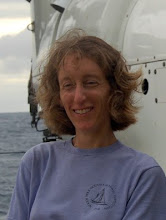Tuesday, August 31, 2010
Lots of time to practice Hiragana and Katakana
Susan and I just arrived safely in Guam after 3 flights over about a day and a half. We had lots of time to practice our Japanese lessons (note the Katakana worksheet shown in the photo). We look forward to meeting our colleagues from JAMSTEC and University of Tokyo. They will arrive tomorrow.
Saturday, August 28, 2010
Where is the southern Mariana Trough?
Susan and I are leaving tomorrow for our cruise to the southern Mariana Trough. This region is a back-arc spreading center - the back-arc of the Mariana Arc and the Mariana Trench, where the Pacific Plate is subducting under the Phillipine Plate. You can learn more about the geophysics in this region in a recent paper by Becker et al. (2010) Geochem. Geophys. Geosyst., 11, Q04X13, doi:10.1029/2009GC002719. The southern Mariana back-arc was recently listed as a region of "highest international priority" for hydrothermal studies by the InterRidge Working Group on Long-Range Exploration (http://www.interridge.org/WG/Exploration).
Friday, August 20, 2010
Equipment and supplies shipped to Guam
On Tuesday, we shipped our instruments, mooring gear, and supplies to the ship's agent in Guam. Susan and I have spent weeks gathering all the things that are now itemized on a big spreadsheet and distributed into 11 packages weighing 4000 lbs! Why does the shipment weigh so much? The heaviest "package" is actually a rack of steel anchor weights (for the plankton pump moorings, which will be described in a later post). The plankton pump boxes, with extra batteries, each weigh over 300 lbs. I am writing on one of these in the attached photo. Also in the photo, you can see our red boxes (heavy with mooring hardware), black totes (with lab and office supplies), and miscellaneous other gear such as polypro line and buckets.
Sunday, August 15, 2010
Testing instruments
In preparation for our cruise, Susan and I have been conducting bench and dock tests of the instruments that will go on our moorings. For example, the photo shown here was taken during our test of an Aanderaa RCM8 current meter. This current meter is an older style, with a rotor and vane. It has served our lab group well on previous cruises, and we hope it will do the same at 3000-m depth in the southern Mariana Trough. The current meter will help us know whether the near-bottom flow was along- or across-axis during our plankton pump sampling near on- and off-axis vents.
Monday, August 2, 2010
Study sites within the Marianas Trench Marine National Monument
Since the discovery of deep-sea hydrothermal vents, scientists have been perplexed by the question: How are these vent sites colonized and, more specifically, How are the faunal populations established and maintained at these very discrete and often ephemeral habitats? The cruise in September 2010 will visit three of the Vents (Volcanic) Unit sites in the U.S. Marianas Trench Marine National Monument: South Backarc (also called Snail), Archaean, and Pika. The larval studies that we will conduct with our Japanese colleagues will help address the question of how populations of vent-endemic species are connected at hydrothermal vents within the Monument. For more information about the Monument, which was established in 2009, please see: http://www.fws.gov/marianastrenchmarinemonument/. You can see a map of the Monument on the Friends of the Monument blog: http://marianamonument.blogspot.com/2009/06/mariana-trench-marine-national-monument.html.
Subscribe to:
Posts (Atom)





